The M-phase specific hyperphosphorylation of Staufen2 involved the cyclin-dependent kinase CDK1
- PMID: 28705199
- PMCID: PMC5513041
- DOI: 10.1186/s12860-017-0142-z
The M-phase specific hyperphosphorylation of Staufen2 involved the cyclin-dependent kinase CDK1
Erratum in
-
Correction to: The M-phase specific hyperphosphorylation of Staufen2 involved the cyclin-dependent kinase CDK1.BMC Cell Biol. 2018 Sep 10;19(1):20. doi: 10.1186/s12860-018-0171-2. BMC Cell Biol. 2018. PMID: 30200875 Free PMC article.
Abstract
Background: Staufen2 (STAU2) is an RNA-binding protein involved in the post-transcriptional regulation of gene expression. This protein was shown to be required for organ formation and cell differentiation. Although STAU2 functions have been reported in neuronal cells, its role in dividing cells remains deeply uncharacterized. Especially, its regulation during the cell cycle is completely unknown.
Results: In this study, we showed that STAU2 isoforms display a mitosis-specific slow migration pattern on SDS-gels in all tested transformed and untransformed cell lines. Deeper analyses in hTert-RPE1 and HeLa cells further indicated that the slow migration pattern of STAU2 isoforms is due to phosphorylation. Time course studies showed that STAU2 phosphorylation occurs before prometaphase and terminates as cells exit mitosis. Interestingly, STAU2 isoforms were phosphorylated on several amino acid residues in the C-terminal half via the cyclin-dependent kinase 1 (Cdk1), an enzyme known to play crucial roles during mitosis. Introduction of phospho-mimetic or phospho-null mutations in STAU2 did not impair its RNA-binding capacity, its stability, its interaction with protein co-factors or its sub-cellular localization, suggesting that STAU2 phosphorylation in mitosis does not regulate these functions. Similarly, STAU2 phosphorylation is not likely to be crucial for cell cycle progression since expression of phosphorylation mutants in hTert-RPE1 cells did not impair cell proliferation.
Conclusions: Altogether, these results indicate that STAU2 isoforms are phosphorylated during mitosis and that the phosphorylation process involves Cdk1. The meaning of this post-translational modification is still elusive.
Keywords: Cell cycle; Cyclin-dependent kinase; Mitosis; Phosphorylation; RNA-binding protein; Staufen2.
Conflict of interest statement
Ethics approval and consent to participate
Not applicable.
Consent for publication
Not applicable.
Competing interests
The authors declare that they have no competing interests.
Publisher’s Note
Springer Nature remains neutral with regard to jurisdictional claims in published maps and institutional affiliations.
Figures
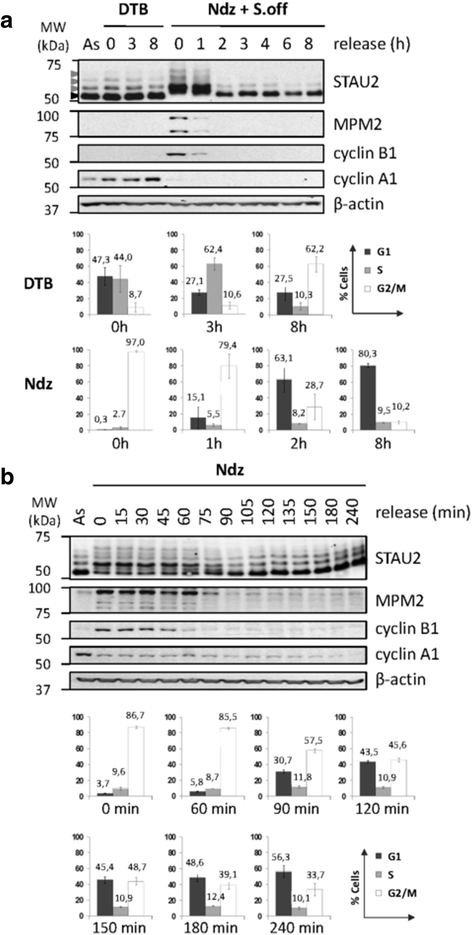
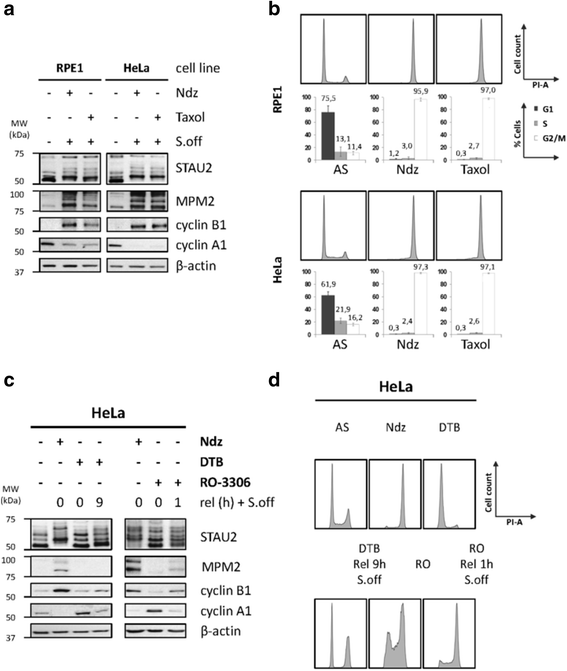
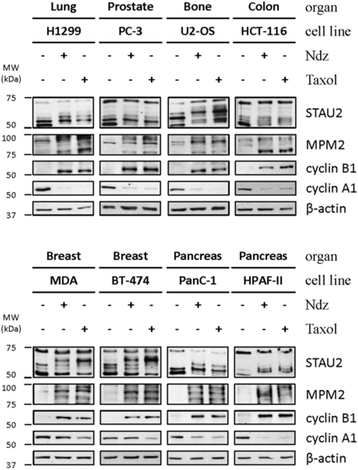
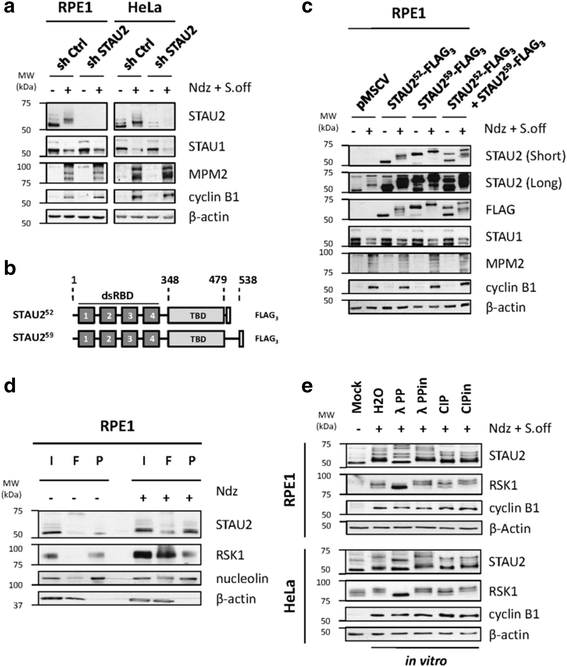
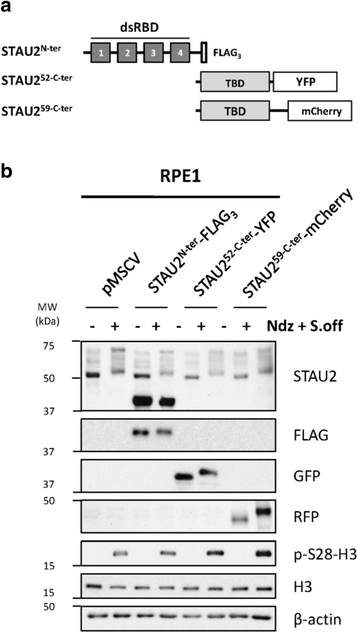

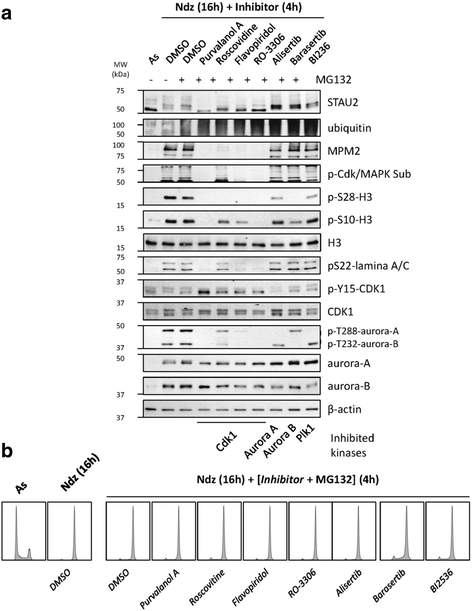
Similar articles
-
STAU2 protein level is controlled by caspases and the CHK1 pathway and regulates cell cycle progression in the non-transformed hTERT-RPE1 cells.BMC Mol Cell Biol. 2021 Mar 4;22(1):16. doi: 10.1186/s12860-021-00352-y. BMC Mol Cell Biol. 2021. PMID: 33663378 Free PMC article.
-
Alternative splicing of Staufen2 creates the nuclear export signal for CRM1 (Exportin 1).J Biol Chem. 2004 Nov 12;279(46):47473-9. doi: 10.1074/jbc.M407883200. Epub 2004 Sep 10. J Biol Chem. 2004. PMID: 15364930
-
A genome-wide approach identifies distinct but overlapping subsets of cellular mRNAs associated with Staufen1- and Staufen2-containing ribonucleoprotein complexes.RNA. 2008 Feb;14(2):324-35. doi: 10.1261/rna.720308. Epub 2007 Dec 19. RNA. 2008. PMID: 18094122 Free PMC article.
-
Two Distinct Cdc2 Pools Regulate Cell Cycle Progression and the DNA Damage Response in the Fission Yeast S.pombe.PLoS One. 2015 Jul 1;10(7):e0130748. doi: 10.1371/journal.pone.0130748. eCollection 2015. PLoS One. 2015. PMID: 26131711 Free PMC article.
-
Temporal regulation of gene expression during the mammalian cell cycle.Curr Opin Cell Biol. 1989 Apr;1(2):275-8. doi: 10.1016/0955-0674(89)90100-2. Curr Opin Cell Biol. 1989. PMID: 2698680 Review. No abstract available.
Cited by
-
STAU2 protein level is controlled by caspases and the CHK1 pathway and regulates cell cycle progression in the non-transformed hTERT-RPE1 cells.BMC Mol Cell Biol. 2021 Mar 4;22(1):16. doi: 10.1186/s12860-021-00352-y. BMC Mol Cell Biol. 2021. PMID: 33663378 Free PMC article.
-
Correction to: The M-phase specific hyperphosphorylation of Staufen2 involved the cyclin-dependent kinase CDK1.BMC Cell Biol. 2018 Sep 10;19(1):20. doi: 10.1186/s12860-018-0171-2. BMC Cell Biol. 2018. PMID: 30200875 Free PMC article.
-
Systematic Identification of the RNA-Binding Protein STAU2 as a Key Regulator of Pancreatic Adenocarcinoma.Cancers (Basel). 2022 Jul 26;14(15):3629. doi: 10.3390/cancers14153629. Cancers (Basel). 2022. PMID: 35892886 Free PMC article.
References
Publication types
MeSH terms
Substances
LinkOut - more resources
Full Text Sources
Other Literature Sources
Miscellaneous

